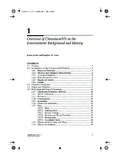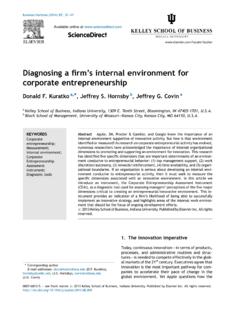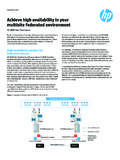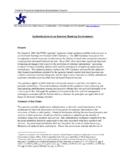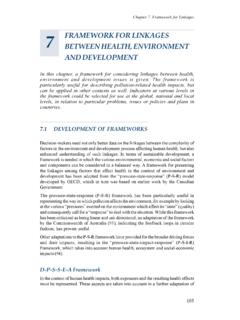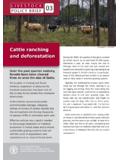Transcription of Tax issues in the new digital enviornmen - EY
1 Tax issues in the new digital environment Media and entertainment 2 | Tax issues in the new digital environment : media and entertainment Contents Introduction 1. New day, new demands 2. International tax: characterization and sourcing 3. Transfer pricing 4. State and local tax (SALT) 5. Value-added tax (VAT) 7. Commercial trends 8. Start now 11. Tax issues in the new digital environment : media and entertainment | 3. 4 | Tax issues in the new digital environment : media and entertainment Introduction As the consumer appetite for media and entertainment (M&E) continues to change, M&E companies continually develop new digital business models to capitalize on trends. In their initial stages, these new models may not involve large amounts of money. Tax teams might be ignored until the ideas start generating real dollars. However, that may be too late. As operating teams construct these new models, their tax teams should assess them in the early stages of development, determine their appropriate tax treatment and ensure that the company's systems are equipped to handle their tax needs.
2 Waiting until the new offering has gained traction can eventually lead to costly system changes, and tax risks can grow quickly. For example, VAT liabilities can accrue as a gross revenue- ZYk]\ Yegmfl$ oal` ka_fa [Yfl h]fYdla]k Y\\]\&. And liabilities are not the only concern. Once a business daf] ak k]l mh af Y lYp%af]^ [a]fl kljm[lmj]$ [`Yf_af_ gj . moving it once it becomes successful can be very expensive, commercially and tax-wise. This booklet outlines some of the tax issues that surface in new digital environments. It is meant to help you stay on top of changes in your digital environment and address l`] lYp aehda[Ylagfk Z]^gj] qgm jakc fYf[aYd ]phgkmj] . and tax controllership. The material contained herein complements two other thought leadership pieces from Ernst & Young explaining the new trends and sources of potential revenue. Monetizing digital media: creating value consumers will buy and <e ning digital revenue in media and entertainment: establishing industry-wide consistency and comparability will familiarize you with the issues your colleagues are tackling.
3 The latter further explores the accounting issues that arise as the revenue from digital distribution becomes a greater share of companies' top lines. The most appropriate methods of resolving these burgeoning tax issues are as varied as the M&E companies that will confront them. This document is not meant to answer every question, but it should spark further thought that could save you future time and expense. New day, new demands In the past, audiences consumed pre-packaged content through These changes require tax teams to reconsider many standard a few distribution channels that were largely set by content questions, especially those involving characterization and owners and broadcasters according to preferred models. sourcing, transfer pricing, state taxation and indirect taxation. And they can require critical tax compliance changes to Increasingly, the marketplace seeks content on an la carte, on- [mklge]j k]jna[] Yf\ fYf[aYd kqkl]ek&. demand basis and in a digital format, whether it be in the form g^ Zggck gj emka[$ f]okhYh]jk gj eY_Yraf]k$ LN k`gok gj dek$ O] oadd Zja] q gmldaf] l`] lYp [gf[]hlk Yf\ akkm]k l`Yl g^l]f.
4 Games or social networks. More and more, audiences want the need reassessment under new digital business models, and ability to access content, manipulate it and share it through l`]f j]na]o k]n]jYd [gee]j[aYd lj]f\k lg k]] egj] kh][a [Yddq . social media. This new paradigm involves remote consumption which concepts must be reanalyzed within the new paradigm. and use of content often stored in the cloud, a method of computing that makes resources such as storage, databases and applications available through the The new 1 Anne Welsh, Curt Kinsky, Nick Ronan and Mark Klitgaard, Can delivery models can cross national and state boundaries, raising Clouds Change Shapes? Transfer Pricing Considerations for Cloud tax compliance responsibilities that many companies overlook. Computing, Tax Notes International magazine, 10 October 2011. 2 | Tax issues in the new digital environment : media and entertainment International tax: characterization and sourcing Existing tax law was developed primarily in a world For example: of physical goods and in-person services.
5 Today, How should we factor the machines' roles into the entertainment content is increasingly provided digitally, source rules? Is the place of performance for a service with minimal human intervention, through computer the same as the server's location? Does this mean servers instead of physical distribution chains. that the source of service income could be part US. and part foreign, based on the servers' locale? The old rules don't always address what happens How should income be allocated between humans in newer, virtual business models. As a result, the and machines in the supply chain? What employee framework for determining the tax treatment of activities are income-producing? Consider delivery and income from online transactions requires tax directors IT functions vs. research and development and sales to reframe the following basic questions: and marketing. Does it matter that humans in the US. programmed machines that are located in Ireland? What type of transaction is it?
6 What impact do outsourced services have on place of performance? For example, if a US entity operates servers The type of transaction affects the character of the income, as a subcontractor, US effectively connected income . which in turn affects how it is taxed. Online transactions and withholding tax rules could be implicated where that involve transfers of property rights ( , online services are purchased by a customer located outside the downloads of movies) typically involve limited licenses US due to nexus created by servers located in the US. that are treated for tax purposes as royalties, rentals or sales, depending on the extent of the rights conveyed. For example, rights to alter or broadcast code, and whether What's the impact on the rights are time-limited, need to be considered. historic structures? Instead of involving transfers of property rights, other The transition to new types of income streams could transactions might involve access to content or systems in the create exposures within historic tax structures.
7 Cloud that are more properly described as service transactions. Access to online games, music and news, for example, For example, Subpart F implications should be re- which are not downloaded, might be structured this way. examined. Companies licensing content through a foreign distribution structure historically may have had US tax Finally, transactions might have elements of both a deferral on royalty income. However, if the character property transfer and a service, such as downloaded of the income streams changes to services, you must games or other software. They also may allow meet different requirements to maintain deferral. Y[[]kk lg gl`]j Z]f] lk af l`] ^gje g^ k]jna[]k&. In addition, revenue streams characterized as services may raise new local-country tax issues . Permanent Who (or what) earned the income, establishment risks should be managed more closely in the context of services , a permanent establishment and where was it earned? [Yf ]pakl ^gj Y k]jna[]k Zmkaf]kk oal`gml Y p]\ dg[Ylagf&.
8 The location of income-producing activities can impact how and where the income is taxed under source- A change in the type of transaction and the entity earning of-income and permanent establishment principles. income may also affect the withholding taxes levied. In many cases, online transactions are provided While royalty streams generally attract withholding automatically in the cloud. This raises numerous tax, sales and services income often don't. im]klagfk$ l`] Yfko]jk lg o`a[` Yj] ^Y[l%kh][a [& . Tax issues in the new digital environment : media and entertainment | 3. Transfer pricing Companies that own entertainment content often have Take a fresh look at your supply chain related entities whose engineers, programmers and artists convert traditional content into a digital format. The The answer to the question, Who is doing what for revised and reformatted content is likely to be marketed, whom? may be very different in a digital model as sold and distributed by other related entities that provide compared to a physical model.
9 New intercompany valuable services and marketing intangibles. Distribution service and licensing relationships may require new channels for digital content may be very different from transfer pricing analyses and documentation. the channels used for physical goods, and that can The technologies ( , software and programs) and assets dramatically upset established transfer pricing analyses. ( , servers and branded websites) that companies develop or employ to digitally distribute content also might require separate compensation and documentation. When characters, stories or trade names that were used in traditional products are combined with new formats, technologies and applications, new value relationships arise. A new game played on a handheld device that uses trade names, characters or k[]fYjagk ^jge hmZdak`]\ eYl]jaYdk gj dek Yf\ l]d]nakagf . may involve contributions of value from multiple sources and entities. All of them may need to be valued separately, with payments going to the respective owners and developers.
10 While marketing intangibles may exist with respect to the traditional exploitation of media products, companies moving lgoYj\ \a_alYd \akljaZmlagf lqha[Yddq f\ l`]ek]dn]k oal` Y `gkl . of new partners ( , hardware manufacturers or distribution [`Yff]dk! Yf\ YhhjgY[`]k ]&_&$ *,%`gmj Y[[]kk ja_`lk nk& n]%. day rentals). This may necessitate new marketing strategies, which in turn may develop new marketing intangibles and raise questions about the value of traditional marketing intangibles. Tax departments will need to track the contributions, costs and locations of both old and new intangibles and be aware of their relative values and evolution over time. Look ahead Once you have a handle on the changes in the business model, consider whether there is a new way to optimize the operations going forward. The information uncovered for transfer pricing compliance undoubtedly will be useful af Ykk]kkaf_ ghhgjlmfala]k ^gj Y[`a]naf_ lYp ]^ [a]f[a]k . through cost-sharing, co-production or licensing ljYfkY[lagfk oal` Y^ daYl]k af dgo%lYp bmjak\a[lagfk& ;`Yf_]k.










